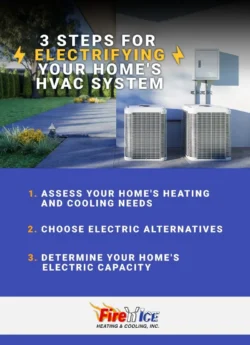
Electrifying your home’s HVAC system is becoming an increasingly popular option for homeowners looking to reduce their carbon footprint and save on energy costs. By transitioning from traditional fossil-fuel-based systems to electrically powered systems, you can improve the energy efficiency of your home while also helping to reduce greenhouse gas emissions.
In this guide, we’ll discuss the steps you can take to electrify your home’s HVAC systems, including assessing your heating and cooling needs, choosing electric alternatives, determining your home’s electrical capacity, considering renewable energy sources, hiring a licensed professional, and scheduling regular maintenance. With these steps, you can successfully electrify your home’s HVAC systems and enjoy the benefits of a more environmentally friendly and efficient home.
ASSESS YOUR HEATING AND COOLING NEEDS
Assessing your heating and cooling needs is an important first step in electrifying your home’s HVAC system. Here are some factors to consider:
- The size of your home: The larger your home, the more heating and cooling capacity you will need.
- Insulation: The amount and quality of insulation in your home will affect how much heating and cooling you need. A well-insulated home will require less heating and cooling than a poorly insulated home.
- Local climate: The climate where you live will affect how much heating and cooling you need. For example, if you live in a hot and humid climate, you’ll need more cooling capacity than if you live in a cooler climate.
- Occupancy: The number of people living in your home will affect your heating and cooling needs. More people means more heat generated, which can increase your cooling needs.
- Lifestyle: Your lifestyle can also affect your heating and cooling needs. For example, if you work from home and spend most of your time indoors, you’ll need more heating and cooling than if you’re away from home for most of the day.
By considering these factors, you can get a better understanding of your heating and cooling needs and choose an HVAC system that is appropriately sized for your home. An HVAC professional can help you determine your specific needs based on these factors and other considerations.
CHOOSE ELECTRIC ALTERNATIVES
Choosing electric alternatives is the next step in electrifying your home’s HVAC system. Here are some options to consider.
ELECTRIC FURNACE
An electric furnace uses electricity as its power source to heat your home. They are typically less expensive to install than gas furnaces and have lower operating costs, especially if you have access to renewable energy sources.
ELECTRIC AIR CONDITIONER
An electric air conditioner uses electricity to cool the air in your home. They can be more energy-efficient than traditional air conditioners and have lower operating costs.
HEAT PUMP
A heat pump uses electricity to transfer heat from one place to another, providing both heating and cooling for your home. They are highly energy-efficient and can be powered by renewable energy sources.
DUCTLESS MINI-SPLIT SYSTEM
A ductless mini-split system uses an electric compressor to provide both heating and cooling to individual rooms or zones in your home. They are highly energy-efficient and can be installed without ductwork.
DETERMINE YOUR HOME’S ELECTRICAL CAPACITY
Determining your home’s electrical capacity is an essential step in electrifying your home’s HVAC system. Here’s what you need to know.
ELECTRICAL LOAD
Your electrical load is the total amount of electricity your home uses at any given time. To determine your electrical load, add up the wattage of all your appliances, lights, and electronics. You can find the wattage on the label or in the user manual.
ELECTRICAL PANEL
Your electrical panel is where the main circuit breaker is located. It is responsible for distributing electricity throughout your home. Check the electrical panel to see how much electrical capacity is available.
UPGRADES
If your home’s electrical capacity is not sufficient to handle the additional load from an electric HVAC system, you may need to upgrade your electrical panel or wiring. A licensed electrician can advise you on any necessary upgrades.
LOCAL REGULATIONS
Local regulations may dictate the maximum amount of electrical capacity allowed for a residential property. Make sure to check with your local authorities before making any changes to your electrical system.
By determining your home’s electrical capacity, you can ensure that your electrical system can handle the additional load from an electric HVAC system. A licensed electrician can help you evaluate your electrical system and make any necessary upgrades.
DOWNERS GROVE’S HVAC EXPERTS
If you are looking into electrifying your home’s HVAC system in Downers Grove, IL, Fire ‘n’ Ice Heating & Cooling, Inc. can help. We specialize in residential and commercial heating and cooling services, including repair, maintenance, and installation. We are a Carrier Dealer and offer indoor air quality solutions. Call today to learn more about our company and to schedule a consultation.
